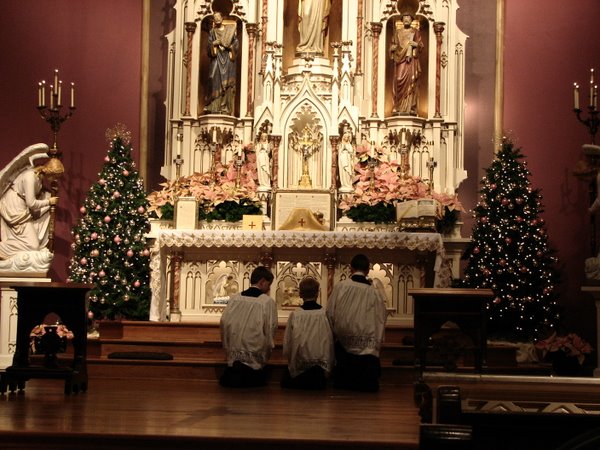From U.S. News and World Report:
A Return to the Latin Mass
Clashes with congregants may erupt as a growing number of young priests push for a revival of pre-Vatican II customs
By Eric Ferkenhoff
Posted 6/17/07
Nearly two generations of Catholics now have grown up in a post-Vatican II world, worshipping in a church that celebrates mass in their local languages and, at least to some extent, embraces modern customs as much as it once rejected them.
So it seemed anathema when the Vatican confirmed recently that Pope Benedict XVI would relax restrictions on celebrating the 16th-century Tridentine Mass, citing "a new and renewed" interest in the ancient Latin liturgy, especially among younger Catholics.
Given the fierce fight that preceded Vatican II—the liturgical and doctrinal reforms of the mid-1960s that sought to make the church more accessible—a similar war would seem needed to overturn them. But a movement is building at seminaries nationwide to do just that: In addition to restoring the Latin mass, young priests are calling for greater devotion to the Virgin Mary, more frequent praying of the rosary, and priests turning away from the congregation as they once did. Perhaps most controversially, they also advocate a diminished role for women, who since Vatican II have been allowed to participate in the mass as lay altar servers and readers.
Such changes would seem to aggravate the church's growing attendance problems(in 2003, 40 percent of Roman Catholics said they had attended church in the past week, down from 74 percent in 1958) as well as enhance its air of exclusivity—the notion of Catholicism as the only true faith. Yet proponents of the movement argue that just the opposite holds: More people will attend mass if the traditions are richer and the doctrine stricter. The Latin mass, they say, would restore a sense of community they believe was diluted when the church allowed local culture to override tradition. In Chicago alone, mass is now said in some 50 languages.
"The traditional Latin mass simply excels at conveying the majesty and mystery of God," says Michael Dunnigan, a canon lawyer and chairman of the pro-Latin mass group, Una Voce America. Rejecting comparisons to fundamentalism, he denies that proponents are simply seeking more structure and discipline. "At the heart of the movement is a longing for beauty and an attitude of profound reverence," he says. Andrew Vogel, a seminarian from Rochester, Minn., notes that before Vatican II, mass attendance was at its highest and seminaries were full. "People just think we must have been doing something right," he says.
In today's Catholic churches, priests are free to celebrate a contemporary Latin mass, but they cannot celebrate the Latin mass as it was structured before 1962 without permission of their bishop. It is this restriction that the pope is considering lifting.
The proponents of the old Latin mass are said to number no more than 2 percent of Catholics, and polls show that the majority of Catholics embrace the reforms of Vatican II. But the Latin movement may be strong enough to carve a divide. Thomas Reese, a fellow at the Woodstock Theological Center at Georgetown University predicts "a clash of cultures between clergy and the more liberal congregations as more of these conservative priests graduate and make their presence known."
He predicts that other old practices will be restored as the Vatican tries to impose the conservative values of Benedict on a more liberal world. "This is so much more about politics than it is about Latin and liturgy," Reese says.
According to published reports, the pope was, among other things, trying to bridge a divide with the traditionalist Society of St. Pius X, even though that group has expressed concern about reversing the gains of Vatican II.
The Latin movement also has its detractors outside the faith. Jewish leaders take offense with older rites' references to Jews as faithless, and they worry that a revival of the old traditions could foster anti-Semitism.
But such arguments seemed far from the minds of the 20-odd worshipers who gathered last Friday for the Latin mass at Chicago's St. John Cantius Church. "You put the old rite and the new side by side, and there really is no comparison," says Simon Varnas, 35. "The old rite is far superior. It is more conducive to prayer, recollection, and personal dedication."
This story appears in the June 25, 2007 print edition of U.S. News & World Report.












No comments:
Post a Comment